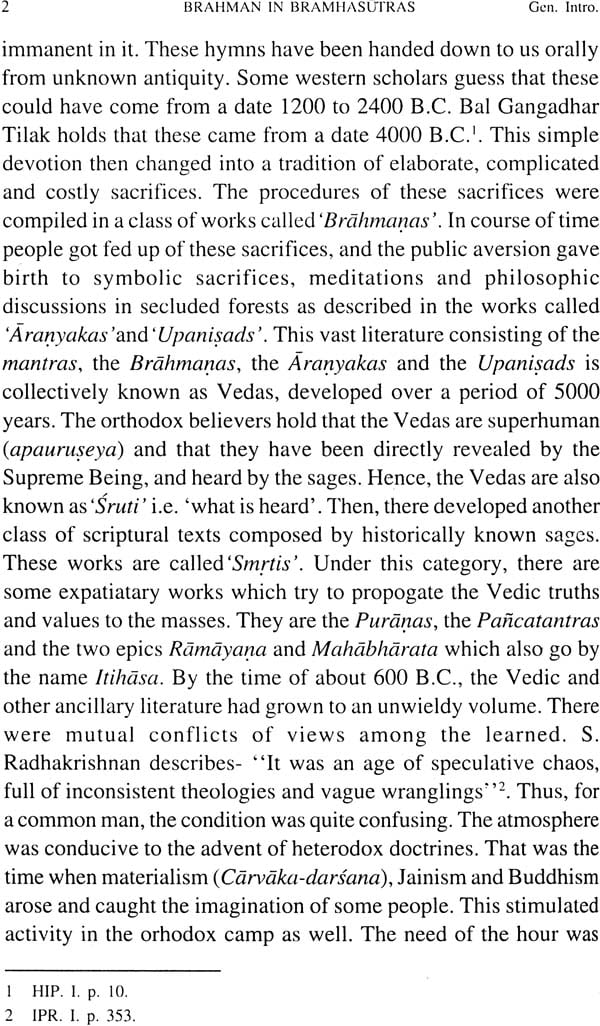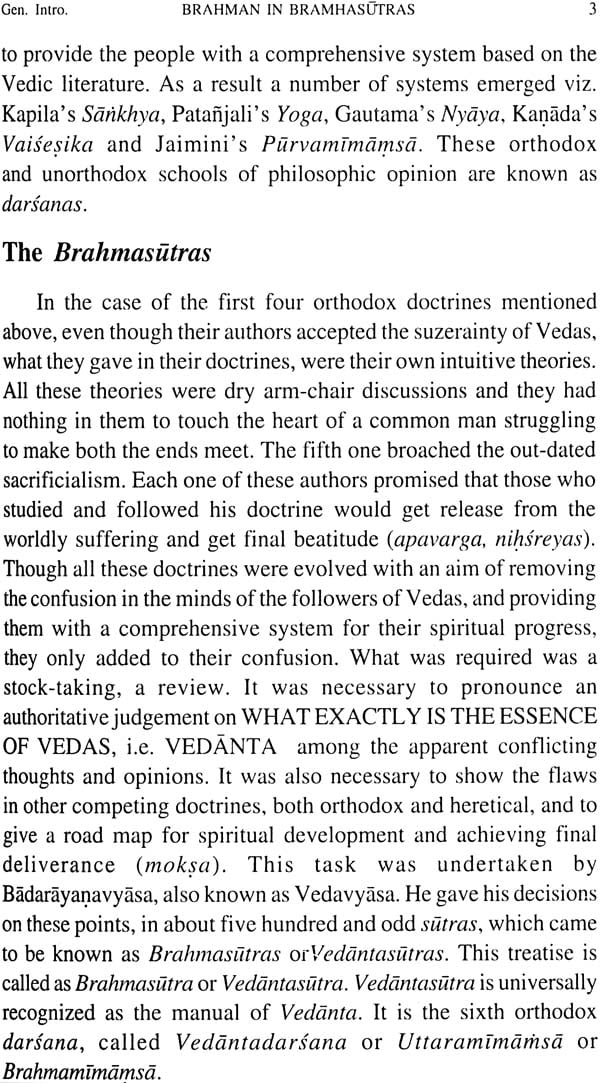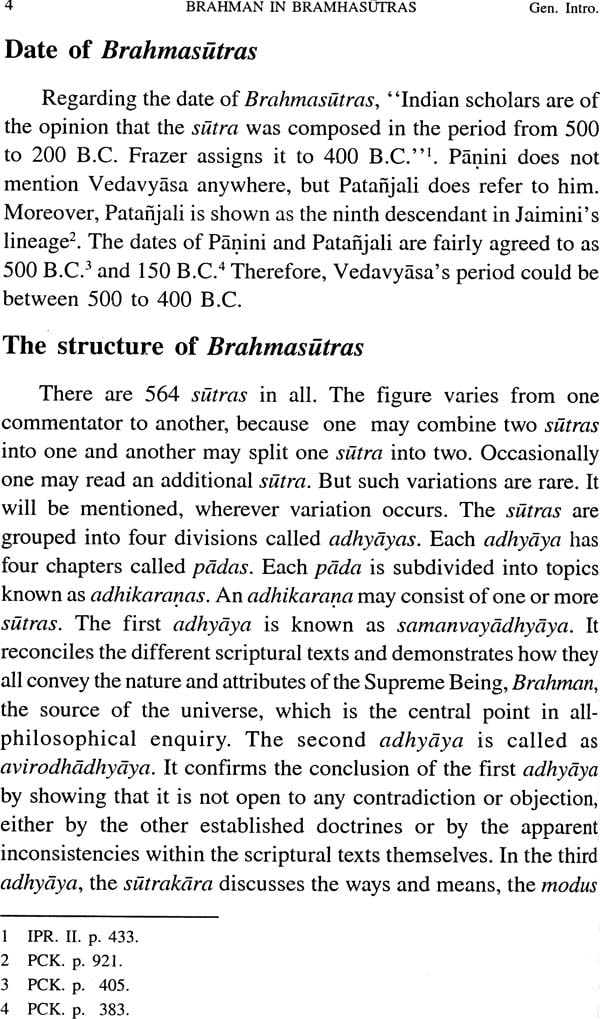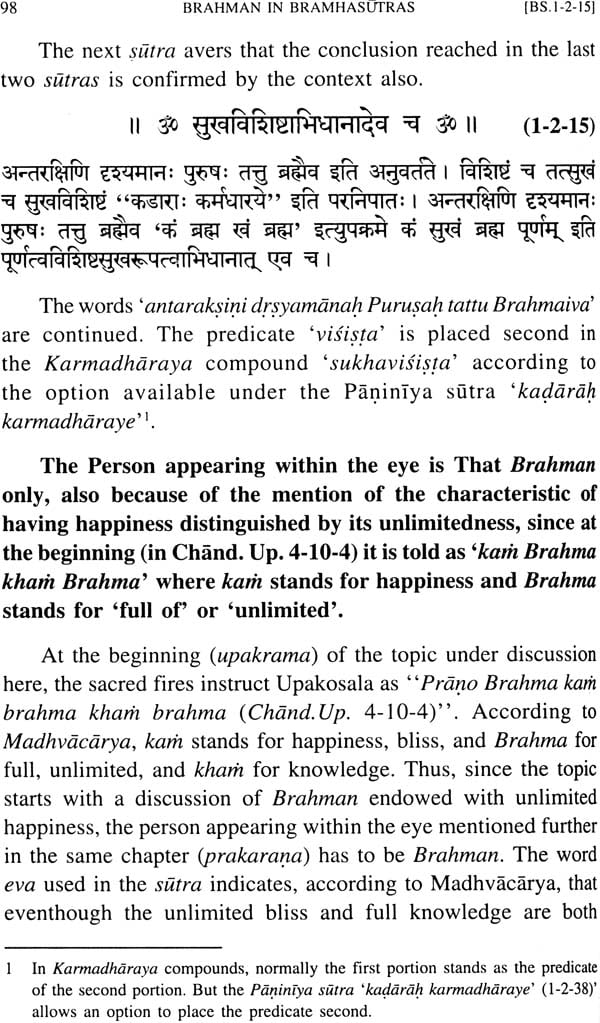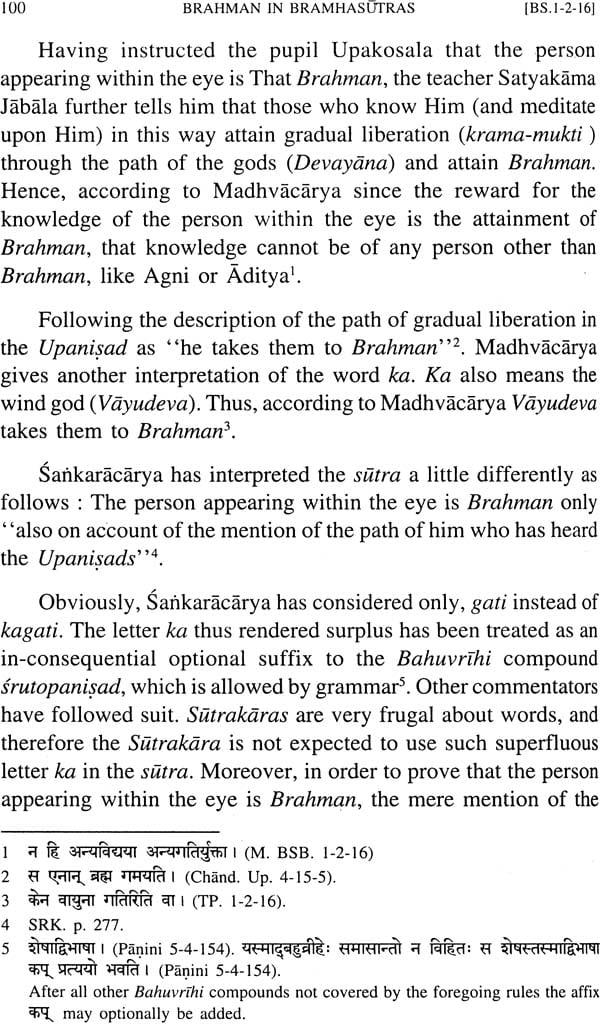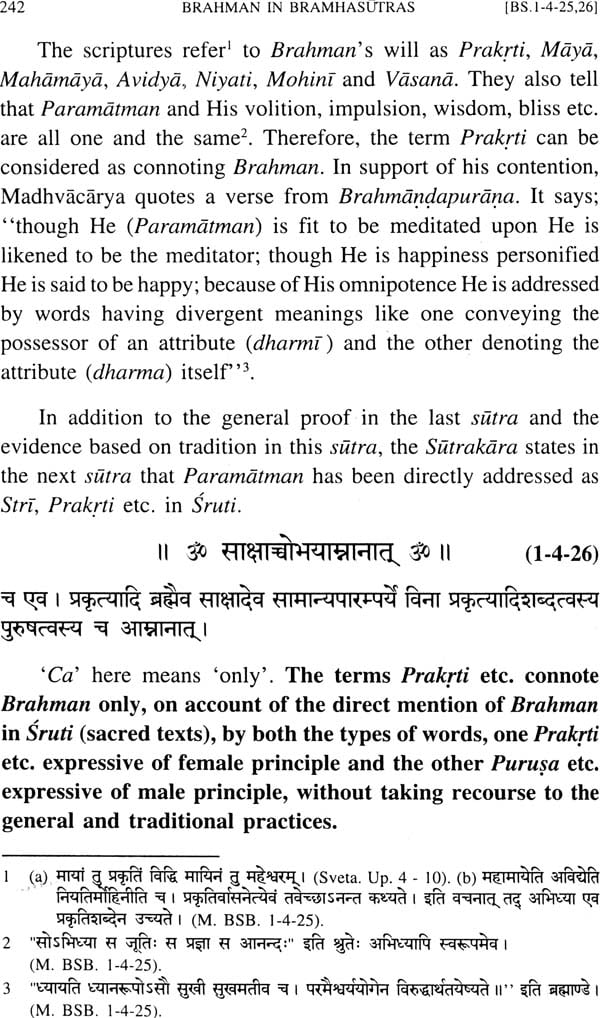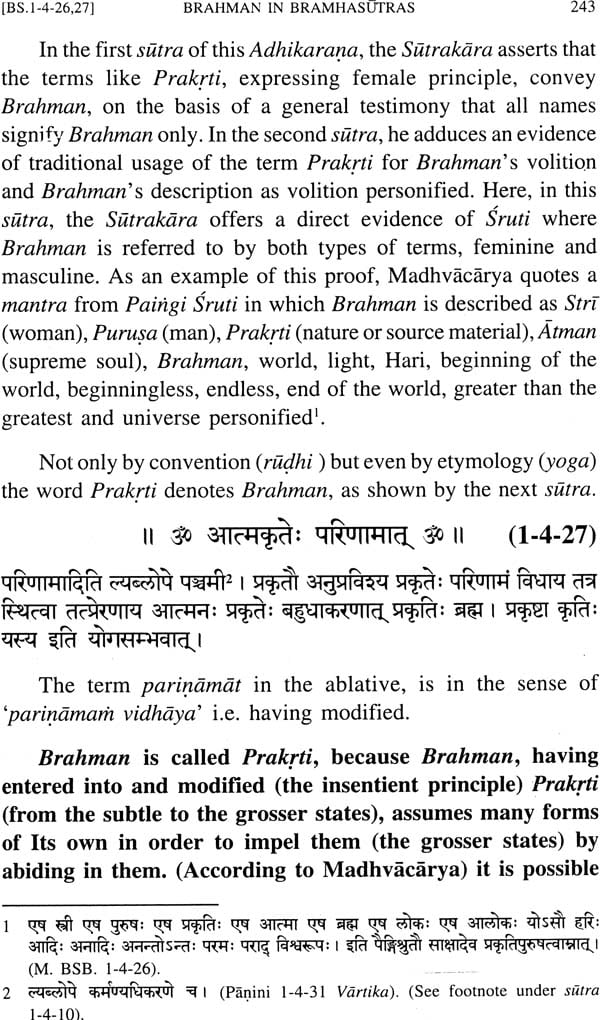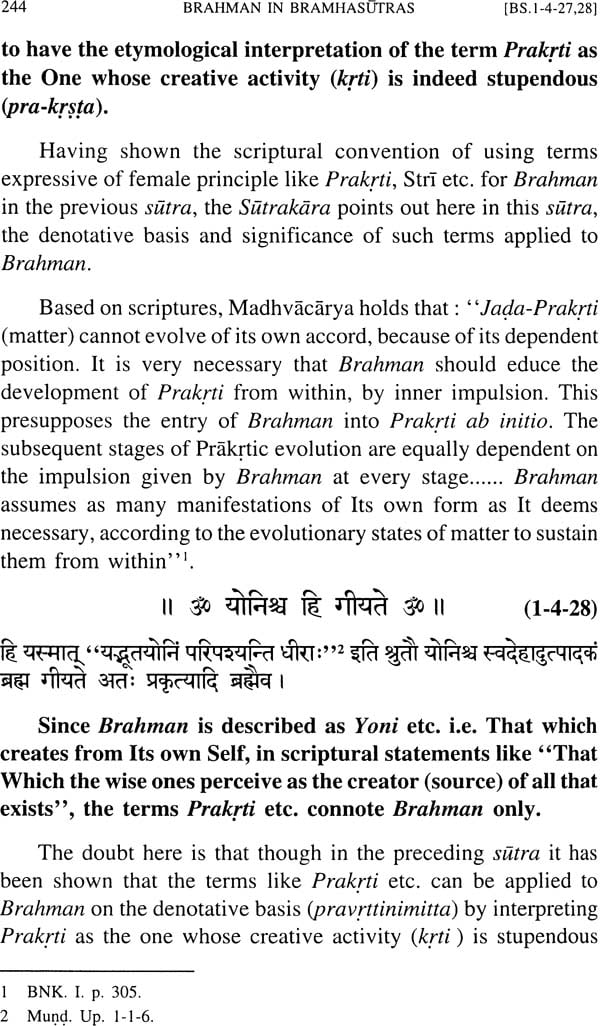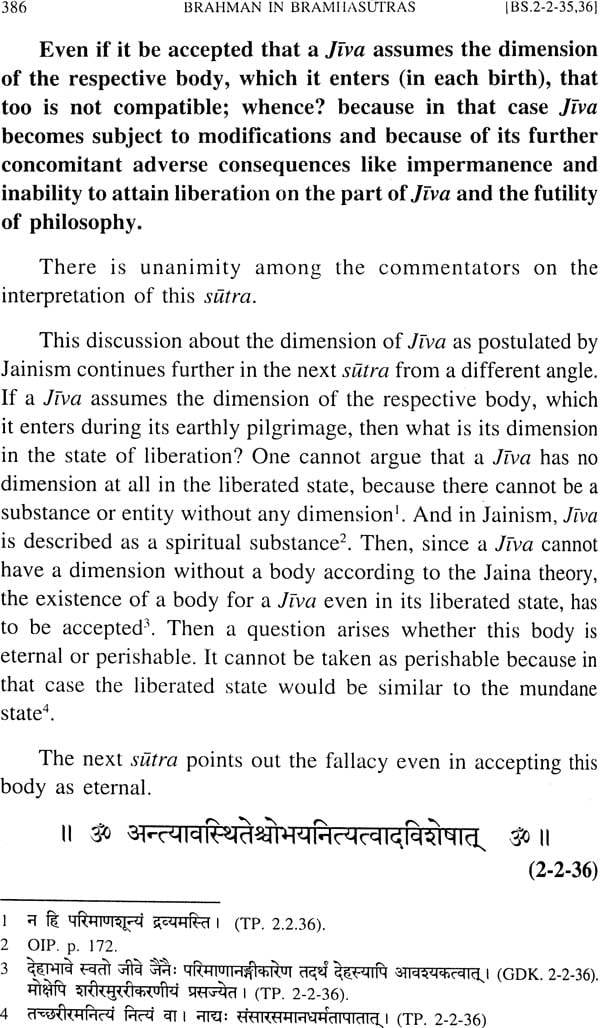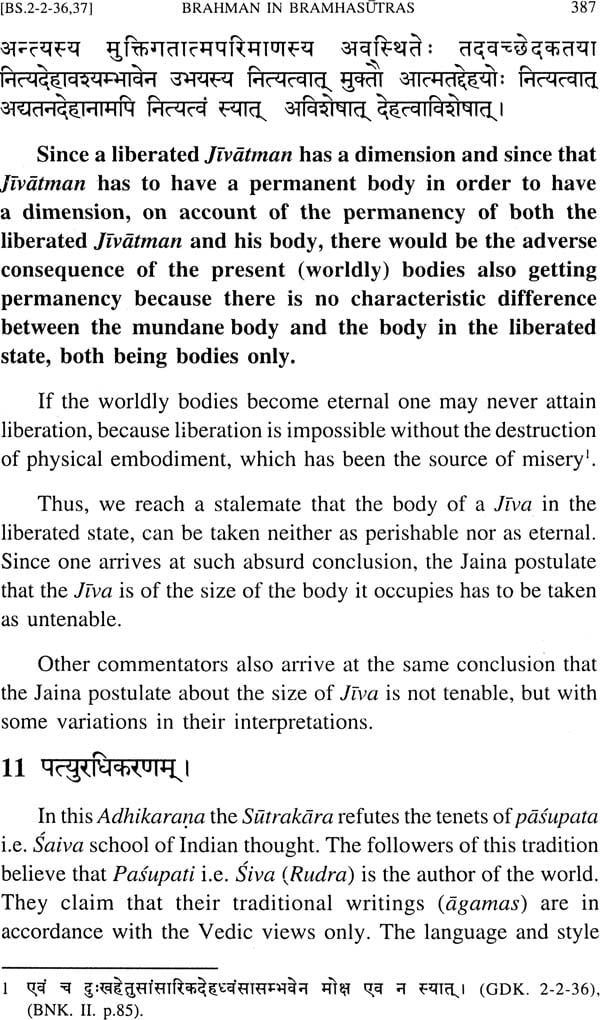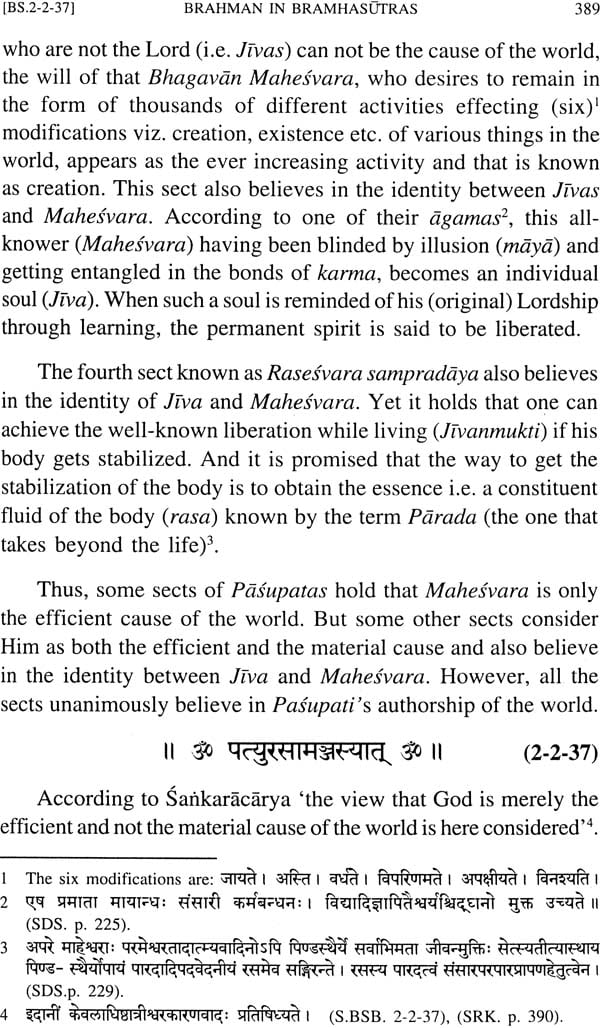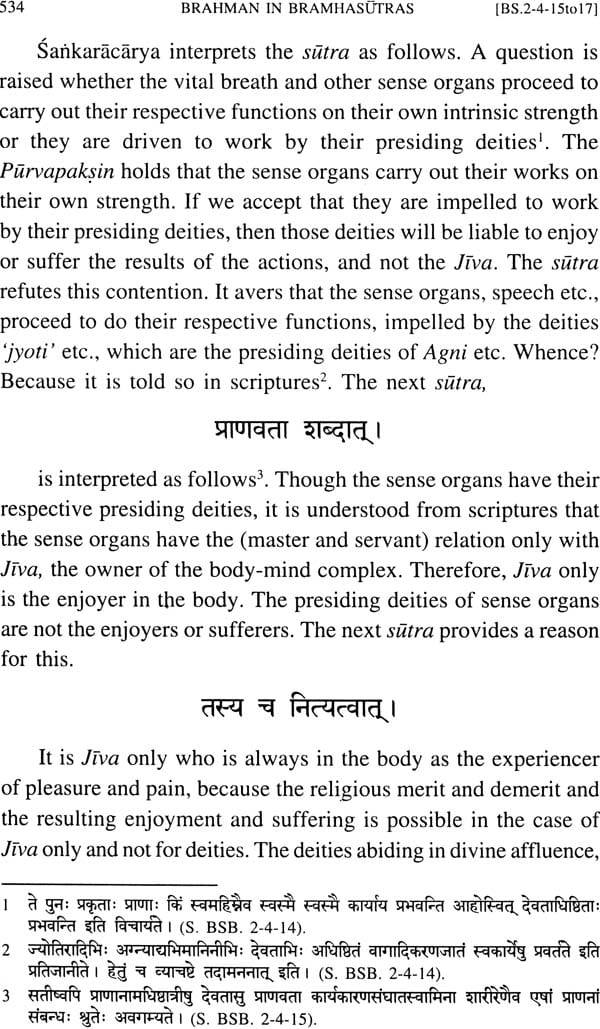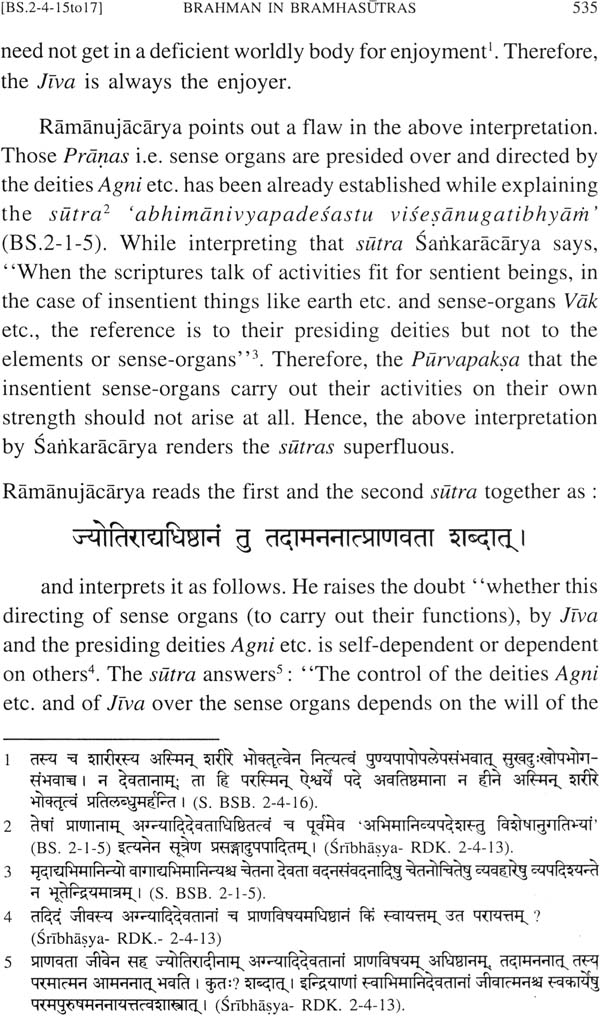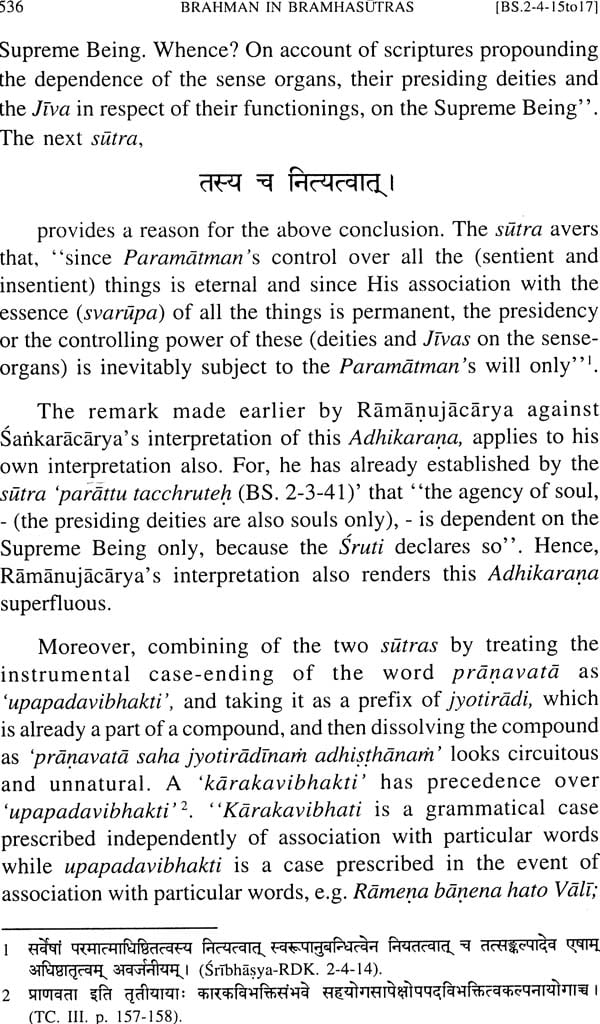
Brahman: The Supreme Being in Brahmasutras (A Commentary on the First Two Chapter of Brahmasutras)
Book Specification
| Item Code: | NAL640 |
| Author: | Dr. Raghavendra Katti |
| Publisher: | Dr. Raghavendra Katti |
| Language: | Sanskrit Text with English Translation |
| Edition: | 2013 |
| ISBN: | 9789381826126 |
| Pages: | 608 |
| Cover: | Hardcover |
| Other Details | 9.0 inch x 6.0 inch |
| Weight | 900 gm |
Book Description
Brahmasutras are the central text of Vedanta Philosopy. The Sutras are arranged in four chapters. The first one is called Saman -vayadhyaya in which Shastrasamanvaya in Brahman is achieved. In the second chapter known as Avirodhudhyaya, the views of other schools of Philosophy, Sankhya, Vaisheshika, Jaina, Bauddha, etc. are rejected. In the third chapter known as Sadhanadhyaya, Vairagya, Bhakti, and Upasana are explained. In the fourth chapter known as Phaladhyaya, Utkranti, Marga and Bhoga are explained.
The Sutras are very brief. Hence it is Difficult to comprehend the import of the Sutras. The three Bhashyakaras, Shankara, Ramanuja and Madhva have explained the import of Sutras in favour of their respective doctrines. In this book, Shri Raghavendra Katti has made an objective study of the Sutras in Chapters I and II, following the plan of Sri Madhvacaharya. He gives the details of the plan of samanvaya in the First chapter and the refutation of the doctrines of the other schools in the second.
Shri Raghavendra Katti summarizing these topics presents his conclusion. He has made use of Panini Sutras and Jaimini Sutras to fix the import of Brahmasutras. In the introduction, he has pointed out that Dr. V.S. Ghate’s analysis of Brahmasutras is quite inadequate as he disposes off five Bhashyakaras’ views in two or three sentences on each Sutra.
The present author presents a detailed study of each Sutra. This enables research scholars and students to comprehend the import of Sutras accurately.
I hereby record my appreciation of his scholarly work which is very useful for research students and scholars.
I have great pleasure in welcoming the publication of Ph.D. thesis of Dr. R.K. Katti, under the heading 'BRAHMAN, THE SUPREME BEING, IN BRAHMASUTRAS'. The author says that it is an objective study of Brahmasutras or Vedantasutras and the word Vedanta means the essence of all scriptures like Mantras, Brahmanas, Aranyakas and Upanishads - of course Upanishads form the final portions of Veda - and hence Vedanta should not be confined to mere Upanishads as advocated by traditional scholars like Shankaracharya and modern scholars like Prof. S. Radhakrishnan and others. He has presented an objective study of these Sutras referring to the three great Acharyas' commentaries and subcommentaries of their great desciples like Jayatirtha, Vyasatirtha and Raghavendratirtha. But his main thrust is to find out the real import of the Sutras in the light of syntax, grammar and semantics of the very wording of the Sutras and their context, citing the quotations from Panini wherever necessary and following the Mimansa method of interpretation in case of some Sutras. Without any preconceived notion, and any bias, he has tried to judge interpretation of each commentator on the basis of certain unacceptable liberties taken by the latter, not warranted by the context of syntax and semantics of the wording of the Sutrakara himself. He cites the examples of liberties such as,
(i) commentator's disagreement with the Sutra itself,
(ii) Arbitrary treatment of some Sutras as Purvapaksha Sutras without any indicatory words therein,
(iii) Repeatedly coming to the same conclusion thereby rendering some Sutras redundant,
(iv) Adoption of secondary meaning (Iakshana) of a word even when the primary meaning has not failed to give a coherent meaning, and
(v) Ignoring the defect of 'split sentence' (vakyabhedadosha).
In support of his view, he has quoted extensively the statements of modem scholars like S. Radhakrishnan, S.N. Dasgupta, and V.S. Ghate and others, and also from various other commentaries. On the basis of this, he has concluded that the Madhvacharya's interpretations of the Sutras are more convincing and are in keeping with the import of the Sutras. One may or may not agree with all his conclusions, but one cannot deny him the credit for his critical acumen and insightful and independent judgement which are the hallmarks of real unbiassed research study. He has reviewed and criticized whenever necessary the statements of not only traditional scholars like Shankaracharya but also the extremist views and comments of modern eminent scholars like Mm. Dr. B.N.K. Sharma, V.S. Ghate and others. The author has presented a crystal clear analysis of almost every Sutra in the first two Adhyayas in the present book and made a comparative study of the commentaries of the three Acharyas, citing his own view with reasons. He has based them mainly on the commentaries viz. Raghavendratirtha's 'Tantradipika' and Vyasatirtha's 'Tatparyachandrika', which are the commentaries on Brahmasutras following Madhvacharya's interpretation.
Such research studies, based on this neglected dimension of philosophical thought as embedded in the entire Vedic literature, Itihasa and Puranas and Agamas, not confining only to the Upanishads, are to be welcomed as rightly pointed out by Prof. S.N. Dasgupta. They add to the contents of realistic philosophy in the Indian philosophical literature in contrast to the dominating view of entire universe as a mere phenomenal show or world of shadows as advocated in abstract monism as per S. Radhakrishnan's observations quoted by the author on page 566.
The present book is thus an important addition to the vast philosophical literature in India. It is a very useful study particularly for research students and all others who are interested in the subject and I hope that it will be welcomed by all.
I congratulate Dr. R.K. Katti for his contribution in this regard and look forward to many more works from his facile pen.
We have great pleasure in publishing this book, 'Bramhan, the Supreme Being, in Bramhasutras'. This is an innovative work by the learned professor, establishing the real purport of the Bramhasutras, with the help of Panini sutras and Jaimini purvamimamsa maxims. He has concluded that the Sri Madhvacarya's interpretations of the Bramhasutras are more convincing.
Sri Madhvacarya (1200-1280 A.D.) is the most erudite philosopher the world has ever seen. He commanded complete knowledge of all the sastras, languages, sciences and the arts. Apart from the Vedas and the Upanisads, he was well versed with the quintessence of epics like the Ramayana, Mahabharata and Srimad-Bhagavata and also the other Indian scriptures in accordance with the original texts. That is why he is aptly referred to as Purnaprajna, the allknower. He has written 37 books which have distilled knowledge of the absolute truth for the benefit of mankind. These works are collectively known as 'Sarvamula Granthas', which can be referred to in English as 'Comprehensive Text of Fundamental Maxims'. Another distinguishing aspect of Sri Madhvacarya is that he was endowed with all the essential thirty two physical characteristics of excellence defined in the sastras that would entitle him to be revered as 'Jagadguru' or 'Visvaguru' (Universal Teacher). He was the master of all branches of knowledge, in the truest sense.
Sri Madhvacarya's life is a fascinating picture of a perdurable philosophical peer that would appeal to all - young and old alike. He possessed excellent knowledge of music and also other forms of art.
His philosophical and literary works are sharp, short, succinct, sweet and precise to the point, with profound import and impact. He has not wasted words. Their meaning and implications are erudite, educative and enthralling. Many commentaries, criticism, explanations and queries on the Sarvamula Granthas keep on appearing from time to time even as eight centuries have elapsed after they were written, which vouch for the versatility of Sri Madhvacarya's doctrines. His works encompass many facets of life that are yet to be properly explored, evaluated and explained. Sri Madhvacarya's life story reads like a series of marvelous events. In physical terms, he was perhaps the strongest person who ever lived in Kali age. He was the embodiment of everything that is good, great, grand and graceful. The mankind is fortunate to have had him as a beacon to look forward to for leading a virtuous and blissful life. He was like a 'Chintamani', a crystal that grants anything one would wish for.
Sri Madhvacarya's legacy has enriched the culture, social mosaic, literature and philosophy of life in the context of the modern day life-style. In particular, Haridasa literature - thousands of hymns that have been composed by several saintly disciples of Sri Madhvacarya has been influenced to a great extent by his teachings and made enormous contribution to the overall betterment of society. What is of great significance is that during the last eight centuries, Sri Madhvacarya's contribution for the upliftment of society has been primordial. This great son of Karnataka has bequeathed enduring philosophical doctrines in his monumental works. It is unfortunate that this has not received proper recognition in the present literary circles. Vaisnava philosophy or Dvaita philosophy propounded by Sri Madhvacarya is the most authoritative doctrine that assures complete upliftment of man. It is the 'kalpavrksa' (a holy tree that grants one's wish) or a 'kamadhenu' (the divine cow that also grants one's wish). There is no doubt that understanding and following his teachings would ensure one's success in life. After Vedavyasa, Sri Madhvacarya's personality comes closest to an outstanding and perfect preacher. That is why he is aptly referred to as 'Abhinava Vedavyasa' (protégé of Vedavyasa].
Sumadhvavijaya of Sri Narayanapanditacarya, Sampradayapaddhati of Sri Hrsikesatirtha and other such works give fairly exhaustive information regarding life, works, disciples and teachings of Acarya Madhva.
Sri Padmanabhatirtha, one of his direct disciples, was one of the outstanding scholars of his time. Sri Naraharitirtha, another direct disciple, even as an ascetic ruled the kingdom of Orissa for over 12 years. Jayasimha, the king of Kasaragod, was one of his staunch followers. Sri Jayatirtha (1365-1388), the celebrated Tikakara of his works, Sri Vyasatirtha of the Vyasatraya-fame, Sri Vadirajatlrtha (Yuktimallika). Sri Raghavendratirtha (Parimala) are some of the prominent exponents of his philosophy.
Sri Madhva's works include commentaries on the Brahma-sutras, Bhagavadgita, Upanisads, Rgveda and Bhagavatamahapurana. His Mahabharatatatparyanirnaya, having 5108 verses, is an unparalleled work in the history of the post puranic literature. Tantrasara-sangraha, Krsnamrtamaharnava, Sadacarasmrti, Yatipranavakalpa are some of his other works dealing with spiritual conduct and rituals. Dvadasastotra and Nakhastuti (as also Kandukastuti) are the stotras composed by him.
As evident from his works, the biographies and other sources of information available on him, Sri Madhva was a multi-faceted, unique personality. He was a scholar, a philosopher, a poet, a Vedic seer, a teacher, a preacher, an orator, a prolific writer, a researcher, a debator, a mystic, a saint, a linguist, an ascetic, a musician, an archaeologist, a logician, a geologist all rolled in one. He excelled in each of these fields. He was also an able administrator, super organiser and social reformer of the highest order. He was the perfect example of an all-rounder in the truest sense of the term. His physique was so perfect that experts in Samudrikasastra could notice all the thirty two characteristics of an ideal personality in it. A huge rock weighing over 50 tonnes lifted by him and placed across the river Bhadra stands as an evidence of his unparalleled physical might. The honourific 'AbhinavaVedavyasa' describes him most appropriately.
His works are marked by the simplicity of style, precision of thought, brevity of expression, unambiguity of presentation and clarity in narration. Profuse quotation from the ancient works is another salient feature of his works.
| Anugrahasandesa or Sri Sri Satyamatrirtha Sripadah | iii | |
| Foreword | v | |
| The Author Narrates | vii | |
| Publisher's Preface | xi | |
| Key to Diacritical marks | xxvii | |
| Abbreviations | xxviii | |
| invocation | xxxii | |
| Brahman, the Supreme Being, in Brahmasutras | 1-576 | |
| I | General Introduction Analysis of Brahmasutras in Adhyaya-I (Samanvayadhyaya) | 1 |
| II | Introduction to Adhyaya-I | 27 |
| III | Pada 1 | 30 |
| IV | Pada 2 | 77 |
| V | Pada 3 | 126 |
| VI | Pada 4 | 188 |
| Analysis of Brahmasutras in Adhyaya-II (Avirodhadhyaya) | ||
| VII | Introduction to Adhyaya-II | 249 |
| VIII | Pada 1 | 251 |
| IX | Pada 2 | 323 |
| X | Pada 3 | 400 |
| XI | Pada 4 | 504 |
| XII | Conclusions & Findings | 552 |

